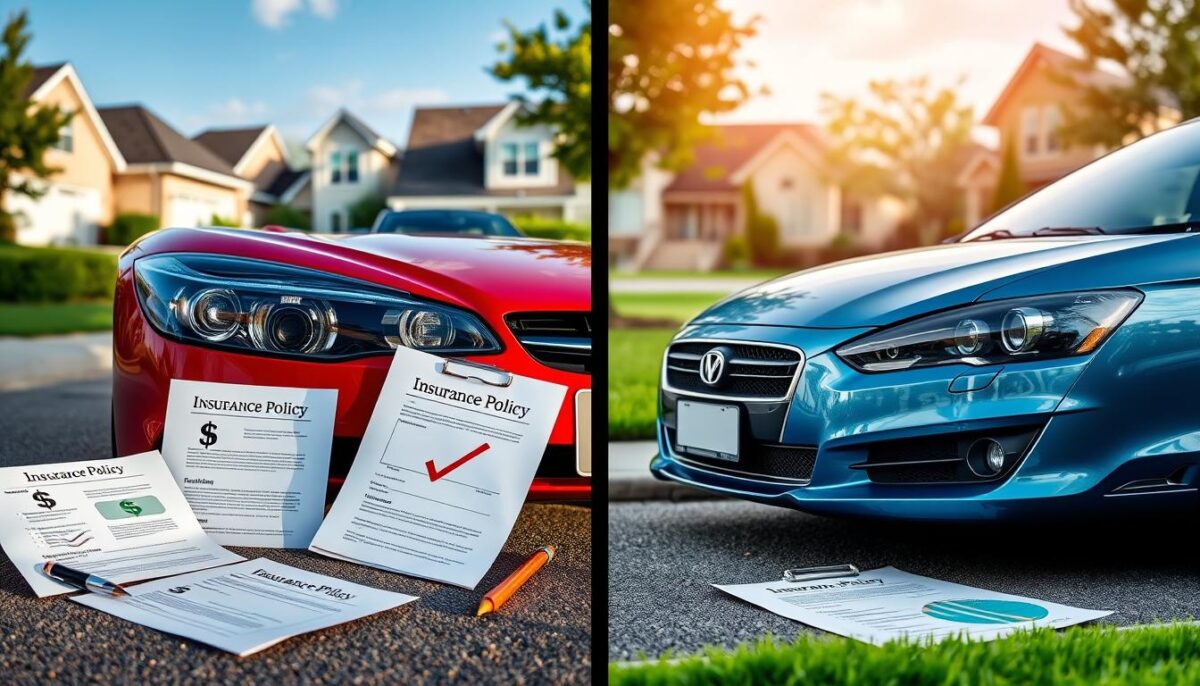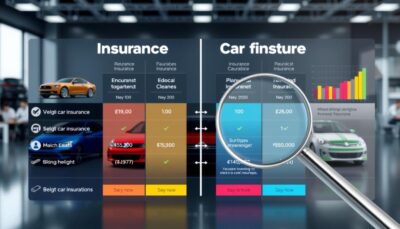Finding the right car insurance can seem hard, but it’s easier than you think. This guide will help you understand how to compare car insurance comparison policies. We’ll cover everything from the different types of coverage to what affects your premium.
We aim to give you the tools and knowledge to make a smart choice. This way, you can find the best rates for your car insurance needs.
Key Takeaways
- Understand the various types of car insurance coverage to ensure you have the right protection.
- Learn about the key factors that influence car insurance rates, such as your driving history and location.
- Discover the benefits of shopping around and compare quotes from multiple insurers.
- Utilize online tools and resources to streamline the comparison process.
- Uncover strategies to maximize discounts and lower your overall insurance costs.
Understanding Car Insurance: What You Need to Know
Car insurance can seem overwhelming, but knowing the basics is key. It helps you compare car insurance comparison policies and find the best rates. Let’s look at the main types of coverage and important terms to understand.
Types of Car Insurance Coverage
Car insurance policies usually have several important coverages. These protect you and your vehicle:
- Liability Coverage: This pays for damages and injuries you cause to others if you’re at fault in an accident.
- Collision Coverage: This pays for repairs to your car if you hit something or someone else.
- Comprehensive Coverage: This covers damage to your car that’s not from a crash, like theft or natural disasters.
- Personal Injury Protection (PIP): This pays for medical costs and lost wages for you and your passengers, no matter who’s at fault.
- Uninsured/Underinsured Motorist Coverage: This protects you if someone with little or no insurance hits you.
Key Terminology Explained
Knowing common insurance terms helps you compare policies and estimate premiums:
| Term | Definition |
|---|---|
| Deductible | The amount you pay before your insurance starts covering costs. |
| Premium | The regular payment you make to keep your insurance policy active. |
| Coverage Limits | The most your insurance will pay for a covered claim. |
| Endorsements | Extra coverage options you can add to your policy for more protection. |
Knowing about car insurance coverage and terms helps you compare car insurance comparison policies. It also lets you find the cheapest insurance that fits your needs.
Why We Should Compare Car Insurance Policies
Exploring car insurance means understanding the value of comparing policies. Shopping around can lead to big savings and the right coverage for us and our cars. We’ll look at why comparing rates is key and how to avoid common mistakes.
Benefits of Shopping Around
Comparing online auto quote options can save us a lot of money. Different insurers offer various rates and discounts. By comparing best car insurance rates, we can find the most affordable vehicle coverage for us.
Shopping around also lets us see more coverage options. This ensures we’re protected in case of accidents or unexpected events.
Avoiding Common Pitfalls
While comparing policies is empowering, we must watch out for common mistakes. One is focusing only on the cheapest premium without checking coverage limits and deductibles. Another is ignoring the insurance company’s reputation and customer satisfaction.
By avoiding these traps, we can choose wisely. We balance cost with reliable protection.
“Comparing car insurance policies is a crucial step in ensuring we have the right coverage at the best possible price.”

In summary, comparing car insurance policies is essential. It helps us save money, tailor coverage, and avoid pitfalls. As we explore car insurance, let’s use comparison to make smart choices. This way, we get the protection and peace of mind we need.
How to Start Your Car Insurance Comparison
Starting a car insurance comparison might seem hard, but we’re here to help. First, gather all the needed info. This will help you get accurate quotes and find the best coverage at good rates.
Gathering Necessary Information
To begin, you’ll need some key details:
- Your personal info, like name, birthdate, address, and driver’s license number
- Info about your vehicle, such as make, model, year, mileage, and VIN
- Your driving history, including any accidents, tickets, or claims
- What coverage you want for liability, collision, and comprehensive insurance
- Your current insurance policy details, if you have one
Online Comparison Tools
With all your info ready, start using online tools to <em>compare </em>car insurance comparison</em> and <em>auto insurance quotes. These tools let you input your info and get quotes from many insurance company comparisons. It’s a great way to find the best deal.
Some top online tools include:
- Insure.com
- The Zebra
- Gabi
- Nerdwallet
- Policygenius
Using these tools, you can easily <em>compare </em>car insurance comparison</em>, a</em>uto insurance quotes, and <em>insura</em>nce company comparisons. This way, you can find the right coverage and rates for your budget.
“Taking the time to compare car insurance comparison options can save you hundreds, if not thousands, of dollars each year. Don’t settle for the first quote you receive – explore your options to find the best value.”
Factors Affecting Car Insurance Rates
Knowing what affects your car insurance rates is key. Your driving history, the car you drive, and where you live all play a part. These factors can greatly change how much you pay for car insurance. Let’s look at how these elements influence your insurance costs.
Driver Factors
Your driving record is a big factor in your car insurance rates. Things like your driving experience, any accidents, and traffic tickets matter. Insurers see drivers with clean records as safer, which can lead to cheaper insurance.
Vehicle Factors
The car you drive also affects your insurance rates. The make, model, age, and safety features of your car matter. Cars with good safety ratings and lower repair costs usually cost less to insure.
Location Influences
Where you live can also change your insurance rates. Things like population density, crime rates, and accident frequency in your area matter. Drivers in busy or accident-prone areas often pay more for insurance.
Understanding these factors can help you find cheaper car insurance. This way, you can get the best coverage for your needs without breaking the bank.
How to Interpret Insurance Quotes
Understanding car insurance quotes is key to finding great rates. By learning to read the details, you can make smart choices. This ensures you get the right coverage at a good price.
Understanding Coverage Limits
When looking at car insurance quotes, coverage limits are crucial. These limits show the max the insurance will pay for claims. Look at bodily injury, property damage, and personal injury protection limits. Make sure they meet your needs.
Evaluating Premiums vs. Deductibles
It’s also important to understand premiums and deductibles. Premiums are what you pay regularly for coverage. Deductibles are what you pay first before insurance helps. Lower premiums mean higher deductibles, and vice versa. Think about your budget and risk level to choose wisely.
“Understanding the details of insurance quotes is essential for making an informed decision and getting the best car insurance coverage for your needs.”
Learning to read insurance quotes helps you find the right policy. Take time to review and compare quotes. It’s worth it in the long run.
The Role of Discounts in Car Insurance
Finding affordable vehicle coverage can be tough. But knowing about discounts can help you get the cheapest car insurance rates. Insurance companies give discounts to reward good behavior and encourage safe driving. It’s important to look for these discounts to lower your premiums.
Common Discounts We May Qualify For
- Safe driving discount: If you have a clean driving record with no accidents or traffic violations, you may be eligible for a significant discount.
- Good student discount: Students who maintain a high academic standing can often qualify for discounted insurance company comparisons.
- Defensive driving course discount: Completing an approved defensive driving course can demonstrate your commitment to safety and earn you a reduction in your rates.
- Multi-policy discount: Bundling your car insurance with other policies, such as homeowners or renters insurance, can result in substantial savings.
- Senior citizen discount: Older drivers may be eligible for discounts based on their age and driving experience.
How to Ask for Discounts
When looking for car insurance, don’t hesitate to ask about discounts. Share your driving history, academic records, and any other policies you have. This way, your insurance provider can check if you qualify for discounts and apply them to your affordable vehicle coverage premium.
| Discount Type | Average Savings |
|---|---|
| Safe Driving Discount | 10-20% |
| Good Student Discount | 15-25% |
| Defensive Driving Course Discount | 5-15% |
| Multi-Policy Discount | 10-25% |
| Senior Citizen Discount | 5-15% |
By using these discounts, you can cut down your cheapest car insurance costs. This way, you get comprehensive coverage at a price you can afford.
The Importance of Customer Reviews
When looking for the best car insurance rates, customer reviews are very helpful. They let you see what real customers think. This can help you make a smart choice. We’ll show you where to find these reviews and how to use them.
Where to Find Trusted Reviews
It’s important to find reviews from trusted sources. Some top places include:
- Independent review websites like J.D. Power, Clearsurance, and Consumer Reports
- Insurance industry publications and financial media outlets
- State insurance department websites
- Online forums and discussion boards where insurance consumers talk
Analyzing Customer Feedback
After finding reviews, it’s key to analyze them carefully. Look for patterns in what people say. Pay attention to things like:
- Claim Handling: How well did the company handle claims?
- Customer Service: How responsive and supportive was the company?
- Value for Money: Did customers think they got a good deal?
- Complaint Rates: Are there any red flags in complaint numbers or types?
By looking at these points, you can understand what customers think. This helps you choose the right insurance for you when comparing car insurance rates.
| Insurance Company | Customer Satisfaction Rating | Complaint Index | Claims Handling Score |
|---|---|---|---|
| Company A | 4.5 out of 5 | 0.75 | 4.8 out of 5 |
| Company B | 4.2 out of 5 | 0.90 | 4.3 out of 5 |
| Company C | 4.0 out of 5 | 1.10 | 4.1 out of 5 |
By looking into customer reviews, you can find the best car insurance for you. This way, you make a choice based on real experiences.
Understanding State Regulations and Requirements
When it comes to vehicle coverage rates, one size does not fit all. Each state has its own set of insurance rules. These rules can change how much you pay for car policy comparison and auto insurance quotes. Knowing these rules is key to getting the right coverage for you.
Minimum Coverage Requirements by State
Every state has a minimum car insurance rule. This rule usually includes liability insurance to protect others on the road. But, the exact rules can differ a lot. Some states might ask for more money for injuries and damage, while others might need extra coverage like PIP or uninsured/underinsured motorist protection.
- In California, the minimum coverage includes $15,000 for bodily injury per person, $30,000 per accident, and $5,000 for property damage.
- New York requires $25,000/$50,000 for bodily injury and $10,000 for property damage.
- Texas has a 30/60/25 requirement for liability coverage.
What to Know About Specialty Insurance
Some driving situations or car types need extra insurance. For example, classic cars need a special policy for protection. Rideshare drivers might need a commercial auto policy or an endorsement to their personal policy.
| Specialty Insurance | Coverage Considerations |
|---|---|
| Classic Car Insurance | Agreed value coverage, higher liability limits, limited usage |
| Rideshare Insurance | Additional liability, collision, and comprehensive coverage |
Knowing the special vehicle coverage rates and insurance needs in your state is important. It helps you compare car insurance comparison policies well and get the right auto insurance quotes for you.
When to Update Your Car Insurance
As our lives change, it’s important to check and possibly update our car insurance. This ensures we have the right coverage at the best rates. Let’s look at when it’s time to review your car insurance.
Life Changes That Warrant a Review
Big life changes can affect your car insurance needs. If you’ve gone through any of these, it might be time to look at car insurance comparison and update:
- Got married or divorced
- Bought a new vehicle or sold an old one
- Moved to a new home or state
- Added a teenage driver to your policy
- Had a change in your credit score
- Filed a claim or had an accident
Annual Policy Review Importance
Even without big life changes, it’s wise to review your insurance premium calculator and policy every year. Your situation and the car insurance market can change, offering affordable vehicle coverage options. An annual review helps you catch any savings or better coverage.
Being proactive about updating your car insurance keeps you protected at the best price. This gives you peace of mind while driving.
Claims Process: What to Expect
When comparing auto insurance company comparisons and car policy comparison, knowing the claims process is key. This is because the real test of an insurer’s trustworthiness is when you file a claim. Here’s what you can expect from start to finish.
Reporting an Accident
The first step is to quickly tell your auto insurance quotes provider about the accident. You can do this online, through their app, or by calling them. Be ready to share the accident’s details like when and where it happened and what happened.
Timeline of Claims Processing
- Claim Acknowledgment: Your insurer will let you know they got your claim and give you a claim number.
- Damage Assessment: An adjuster will check your vehicle’s damage and figure out how much repairs will cost.
- Repair Approval: After assessing the damage, your insurer will okay the repairs and give you a list of shops to choose from.
- Repair Process: You’ll take your car to the chosen shop. They’ll fix it and send the final bill to your insurer.
- Claim Resolution: Your insurer will check the bill and pay for the repairs, either to you or the shop, based on your policy.
The time it takes to process a claim can change based on several factors. These include how complex the case is, how fast everyone involved responds, and how efficient your insurer is. Still, most insurers aim to settle claims quickly to make things easier for you.
The claims process is a big part of your car policy comparison. When looking at auto insurance quotes, think about how well an insurer handles claims. This ensures a good experience if you ever have to file a claim.
Finalizing Your Decision: Choosing the Right Policy
As you near the end of your car insurance comparison journey, it’s time to evaluate the key factors and make your final decision. We understand that selecting the right policy can be a crucial process, so let’s explore the important considerations to prioritize.
Factors to Prioritize
When choosing your car insurance policy, it’s essential to focus on coverage limits, deductibles, and premiums that align with your specific needs and budget. Additionally, reviewing the insurer’s customer service reputation and claims handling track record can provide valuable insight. By weighing these factors carefully, you’ll be well-equipped to find the policy that offers the best value and protection for your driving requirements.
Making the Switch: What to Consider
If you’ve decided to switch car insurance providers, there are a few important aspects to keep in mind. First, ensure a seamless transition by coordinating the cancellation of your current policy and the effective start date of your new coverage. This will help avoid any gaps or overlaps in your protection. Additionally, be mindful of any potential early cancellation fees or prorated refunds from your previous insurer. By planning the switch thoughtfully, you can enjoy a smooth and hassle-free transition to your new car insurance policy.
FAQ
What are the different types of car insurance coverage?
Car insurance coverage includes liability, collision, and comprehensive. It also includes personal injury protection (PIP) and uninsured/underinsured motorist coverage. Each type protects you in different ways and has its own limits and deductibles.
What factors affect car insurance rates?
Your driving history, vehicle type, location, age, and credit score all affect rates. Knowing these factors can help you find ways to lower your premiums.
Why should we compare car insurance policies?
Comparing policies helps you find the best coverage at a good price. Shopping around can save you money and ensure you have the right coverage. It also helps you avoid costly mistakes.
How do we start the car insurance comparison process?
First, gather info on your driving history, vehicle, and coverage needs. Then, use online tools to get quotes from different insurers. This lets you compare policies side-by-side.
What are some common car insurance discounts we may qualify for?
Look for good driver, multi-policy, safe vehicle, and professional discounts. Asking your insurer about these can help lower your premiums.
How do we interpret insurance quotes and coverage limits?
Understand the coverage limits, deductibles, and how premiums and deductibles relate. This knowledge helps you compare car insurance comparison policies effectively and choose the best value.
What should we consider when choosing the right car insurance policy?
Consider coverage limits, deductibles, customer service, and overall value. When switching insurers, cancel your current policy and ensure a smooth transition.







